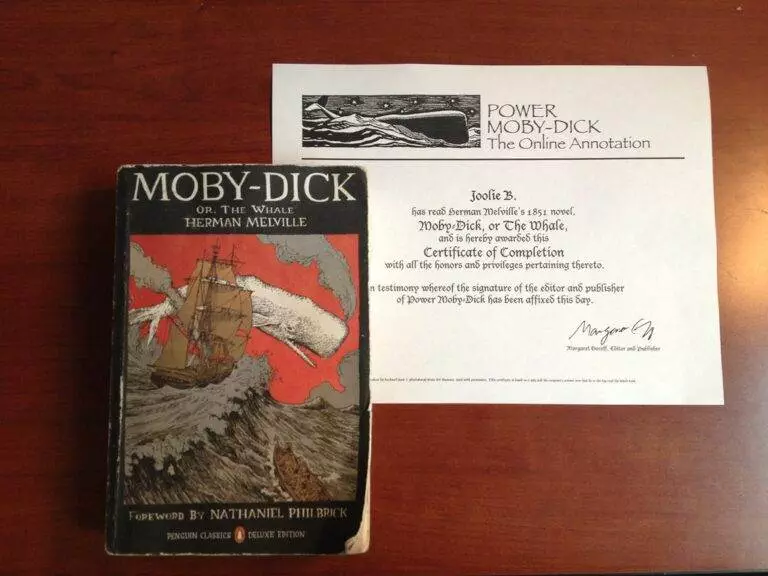Published in 1851, Herman Melville’s Moby-Dick is considered one of the great American novels. The story follows the whale ship Pequod captained by the brooding, vengeful Captain Ahab on his quest to kill the elusive white whale named Moby Dick. Narrated by sailor Ishmael, this epic ocean adventure blends action, allegory, symbolism, and encyclopedic detail into a rich literary masterpiece that tackles humanity’s relationship with nature, evil, and obsession.
Table of Contents
Plot Summary
The narrator Ishmael signs up to work on the Pequod whaling ship sailing from Massachusetts. He is intrigued by the mysterious, scary captain Ahab who remains secluded in his cabin. When Ahab finally appears, he reveals his monomaniacal quest to hunt and kill Moby Dick, an old gigantic sperm whale that had destroyed Ahab’s ship and bitten off his leg on a previous voyage.
Ahab forces the crew to swear loyalty to his mission against the whale. As the ship sails around the world, weird omens occur hinting at doom. The mystical Fedallah prophesies Ahab will die after killing Moby Dick. When the whale is finally spotted, Ahab’s obsession leads the Pequod into a fatal battle. Moby Dick rams and sinks the ship, killing all except Ishmael.
Themes and Analysis
Key themes and ideas explored in Moby-Dick include:
- Dangers of vengeance and obsession leading to destruction
- Man vs nature and limits of human power against forces like the whale
- Ambiguity between heroism and madness
- Violent nature of whaling and marine hunting
- Sublime ferociousness of sperm whales
- Ahab’s hubris and defiance of God or the gods like Prometheus
- Meaning of the color white and leg as symbols
Read These Too:
Melville combined thrilling maritime adventure with deeper philosophical questions. Through highly varied literary techniques like shifting narration, poetry, stage drama and encyclopedic chapters on whaling, he created an innovative hybrid form. The story operates as both a psychological study of obsession and a symbolic moral allegory about humanity.

Herman Melville and Whaling
Born to an old New England family in 1819, Melville worked as a sailor on merchant and whaling voyages before becoming an author. His experiences at sea inspired his early novels.
Key contextual factors:
- Whaling a major 19th century industry but extremely dangerous
- Sperm whales prized for oil used for lighting and machinery
- Whales facing extinction from uncontrolled hunting
- Quakers dominated New England whaling through Nantucket
- Rising industry and ambitions of young America
- Earlier literary sea adventures by Walter Scott and others
Though initially perceived as just thrilling popular adventure fiction, Moby-Dick was rediscovered as a masterpiece in the 20th century and continues to be extensively analyzed.
Analysis of Characters
Captain Ahab – The one-legged captain bent on revenge against Moby Dick at all costs. His obsession drives the plot.
Ishmael – The philosophical narrator who joins the Pequod’s crew. His story frames the central tragedy.
Moby Dick – The mythical giant white sperm whale that cripples Ahab. A force of nature and symbol.

Queequeg – A skilled harpooner from the South Pacific who befriends Ishmael. Embodies interconnectivity of all.
Starbuck – The ship’s principled first mate who debates morality with Ahab. Named after the coffee chain.
Fedallah – The mysterious Parsee harpooner and prophet who eggs Ahab’s death drive. He represents fate.
Significance and Impact
As an epic allegory, Moby-Dick profoundly impacted literature:
- Established the “Great American Novel” quest tackling ideology, evil, fate.
- Inspired immense analysis as a rich allegory with many layers of meaning.
- Ahab as the quintessential mad hero-villain on a monomaniacal quest.
- Melville’s prose style became exemplar of philosophical fiction.
- Structure and techniques like shifting narrator became standards.
- Fed into mythology surrounding whales and inspired environmentalism.
- Illustrations, especially the white whale spouting water became iconic.
- Resonances to Captain Nemo, the white whale of Heart of Darkness, the Old Man and the Sea.
- Popularized the idea of captain’s sacred duty to ship and crew.
- Homosocial bonding of men at sea pioneered in Ishmael and Queequeg’s friendship.
Read These Too:
Why Read Moby-Dick
There are many reasons Moby-Dick is considered a masterwork:
- Melville’s beautiful poetic prose and philosophical depth.
- A thrilling high-seas adventure and a deep moral allegory at once.
- Ahab as the iconic mad hero-villain.
- Ishmael’s thoughtful narration framed around the central tragedy.
- Dramatic scenes like chasing the whale and Ahab’s final fight.
- Powerful symbolism open to myriad interpretations.
- Amazing creative hybridity of forms – drama, essay, poetry combined.
- Psychologically perceptive in its study of obsession and charisma.
- Ambiguous on issues of free will versus determinism.
- Captures both the thrill and darkness of whaling.
- Timeless themes of revenge, humanity’s relation to nature, evil.
Conclusion
Melville’s epic maritime psychological allegory remains as restless and elusive as the the white whale itself even 170 years later. Much more than just a thrilling nautical adventure, Moby-Dick is truly a philosophical novel for the ages plumbing the watery depths of humanity’s relationship with divinity, nature, evil, and that which lies beyond grasp.


